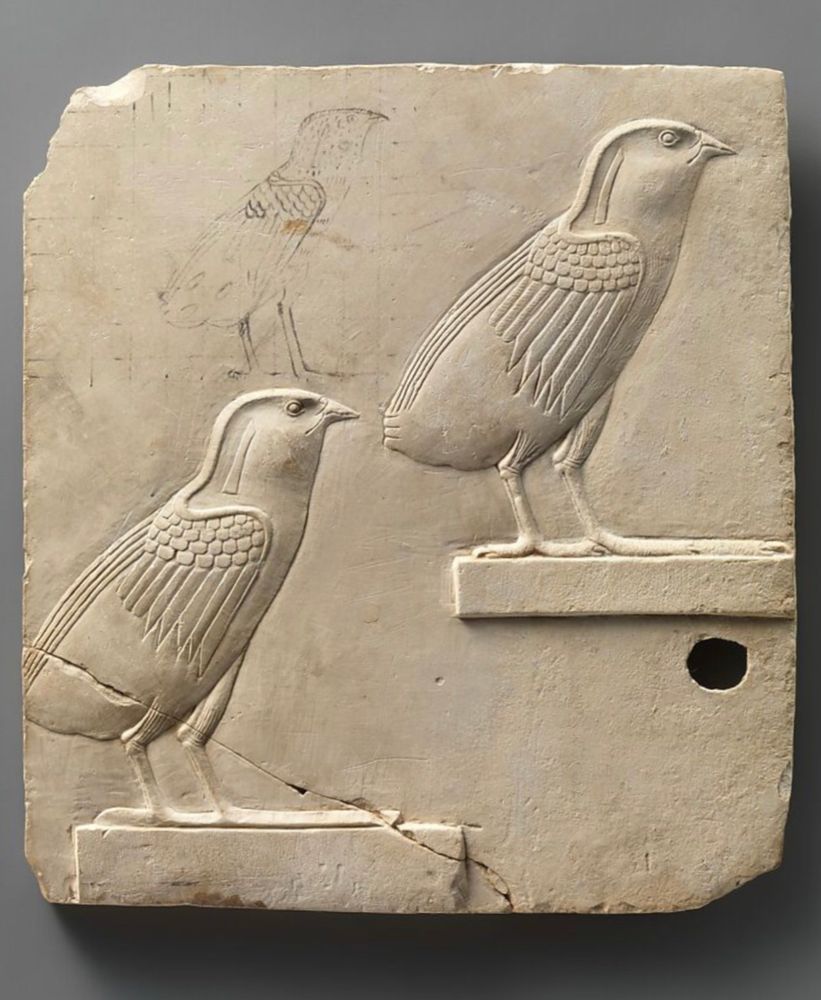
Look closely to see a third chick sketched in ink!
From Egypt, Late Period–Ptolemaic Period, 400–30 BC.
📷 Met Museum www.metmuseum.org/art/collecti...
#ReliefWednesday
#Archaeology




Selon le créateur de la biodynamie, nous descendons des Atlantes. C'est peut être pour ça que nous avons besoin d'alimentation biodynamique (j'y reviens après)
1/7













-Fais-toi confiance. Inspire-toi de ce que tu connais
-C'est vous le boss, boss
(Jean Fouquet, 1470)

-Fais-toi confiance. Inspire-toi de ce que tu connais
-C'est vous le boss, boss
(Jean Fouquet, 1470)
1/5





Roman pottery with Latin inscriptions, made for wine drinking! 🍷
‘Give us wine!’
‘Fill me up!’
‘Well be to you!’
Trier Region, Late 3rd-early 4th century AD. Landesmuseum Trier 📷 by me
#Archaeology
![My photo collage shows three Roman black-slipped pottery vessels with white painted Latin inscriptions and white vine-like flowing decoration set against a rich pinky-purple display case background.
These so-called ‘motto beakers’, decorated with wine-themed Latin inscriptions painted in white slip, were produced in the Trier region during the mid 3rd century. They proved very popular and were exported to Britain and the Danube
Top image: cylindrical cup with straight sides with narrower base. The dark, almost black surface is decorated with large white letters V M N. The inscription around the cup reads VINIVM NOBIIS DA/ Give us wine! There is a band of rope-like white ornamentation near the rim. Beneath the lettering is a vinemotif with cluster of threeroundish ‘grape’ shapes. There are visible cracks where the cup has been restored. From Trier or surroundings, 280-315 AD.
Bottom left: elegant dark jug with a narrow base, rounded body, and long neck that flares outward to a broad lip. A single curved handle connects the neck to the upper body. The decoration includes the large white letters R E P and swirling white scroll ornamentation. The full inscription encircling the jug reads REPLE ME - Fill me up! From Trier, St. Matthias, 280-315 AD.
Bottom right: A cylindrical beaker with a narrower base. White lettering near the top reads E N E T I B. The full inscription around the beaker reads B[ENIE T[BI S]|[T] - Well be to you! Beneath the text is a continuous vine-scroll design with stylised leaves or grapes. From Trier, Louis-Lintz-Straße, 260-270 AD.](https://cdn.bsky.app/img/feed_thumbnail/plain/did:plc:j56ydp325adovobhwpkzc6sp/bafkreidvgcm4meck4zsw7uiucznujg7fw5cdeu2lguukrglcw6t2gxmujq@jpeg)
Roman pottery with Latin inscriptions, made for wine drinking! 🍷
‘Give us wine!’
‘Fill me up!’
‘Well be to you!’
Trier Region, Late 3rd-early 4th century AD. Landesmuseum Trier 📷 by me
#Archaeology
1/2
⬇️
Une ombre offusque mes regards ;
Deux belettes et deux renards
Traversent l'endroit où je passe ;
Les pieds faillent à mon cheval,
Mon laquais tombe du haut mal ;
#Poésie
1/3
⬇️
1/2
⬇️
Une ombre offusque mes regards ;
Deux belettes et deux renards
Traversent l'endroit où je passe ;
Les pieds faillent à mon cheval,
Mon laquais tombe du haut mal ;
#Poésie
1/3
⬇️
Une ombre offusque mes regards ;
Deux belettes et deux renards
Traversent l'endroit où je passe ;
Les pieds faillent à mon cheval,
Mon laquais tombe du haut mal ;
#Poésie
1/3
⬇️

"Il n'imagine pas qu'il puisse exister des rapports entre les mots et les choses, mais il sait qu'il y a des rapports entre les mots et qu'à condition de les alléger de leur sens,
1/3
⬇️
John Dewey, 1941, "The Basic Values and Loyalties of Democracy".

"Il n'imagine pas qu'il puisse exister des rapports entre les mots et les choses, mais il sait qu'il y a des rapports entre les mots et qu'à condition de les alléger de leur sens,
1/3
⬇️
Wateville chez Saint-Simon : https://t.co/hTNqjyMw5e
Haute-Fontaine chez Tallemant : https://t.co/GHrY4YObsR


